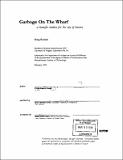| dc.contributor.advisor | Ellen Dunham-Jones. | en_US |
| dc.contributor.author | Russell, Phillip Gregory | en_US |
| dc.contributor.other | Massachusetts Institute of Technology. Dept. of Architecture. | en_US |
| dc.coverage.spatial | n-us-ma | en_US |
| dc.date.accessioned | 2012-03-16T16:00:37Z | |
| dc.date.available | 2012-03-16T16:00:37Z | |
| dc.date.copyright | 1999 | en_US |
| dc.date.issued | 1999 | en_US |
| dc.identifier.uri | http://hdl.handle.net/1721.1/69753 | |
| dc.description | Thesis (M. Arch.)--Massachusetts Institute of Technology, Dept. of Architecture, 1999. | en_US |
| dc.description | Includes bibliographical references (p. 82-89). | en_US |
| dc.description.abstract | Perhaps because they address processes at the expense of space or have many "conditions" limiting architectural design freedom, infrastructure and particularly the infrastructure of waste, are commonly neglected in architectural discourse. This thesis aims at revealing the invisible nature of the waste infrastructure so that through the "architecture of waste" sociological issues regarding use, consumption and recycling can be physically addressed. By bringing the waste infrastructure to the foreground, I hope to engage the academic world and the general public with this emerging real world structure. Today many recycling plants, water treatment plants, landfills, etc. are being constructed without reference to any architectural or landscape precedent. Waste processes and economies of scale wholly determine the form and size of these projects; most recycling plants are huge to allow for large furnaces to melt as much plastic at one time as possible. Through the design of each stage of the waste process, from disposal to decomposition or recycling, it is hoped that the level of design currently appropriated towards it will be raised. It is a goal of the thesis project to design a component of the infrastructure of waste, an infrastructure that appears to have evolved without direction. This thesis proposes the combination of a solid waste transfer station with a public park. To eliminate the stigma of waste treatment and removal pervasive in contemporary society, the central elements of this process should be visible and prominently located in the city. Proposing my transfer station in a highly public location, I hope to celebrate good design and building through a building type not normally given much thought. | en_US |
| dc.description.statementofresponsibility | by Greg Russell. | en_US |
| dc.format.extent | 112 p. | en_US |
| dc.language.iso | eng | en_US |
| dc.publisher | Massachusetts Institute of Technology | en_US |
| dc.rights | M.I.T. theses are protected by
copyright. They may be viewed from this source for any purpose, but
reproduction or distribution in any format is prohibited without written
permission. See provided URL for inquiries about permission. | en_US |
| dc.rights.uri | http://dspace.mit.edu/handle/1721.1/7582 | en_US |
| dc.subject | Architecture. | en_US |
| dc.title | Garbage on the wharf : a transfer station for the City of Boston | en_US |
| dc.type | Thesis | en_US |
| dc.description.degree | M.Arch. | en_US |
| dc.contributor.department | Massachusetts Institute of Technology. Department of Architecture | |
| dc.identifier.oclc | 42618565 | en_US |
